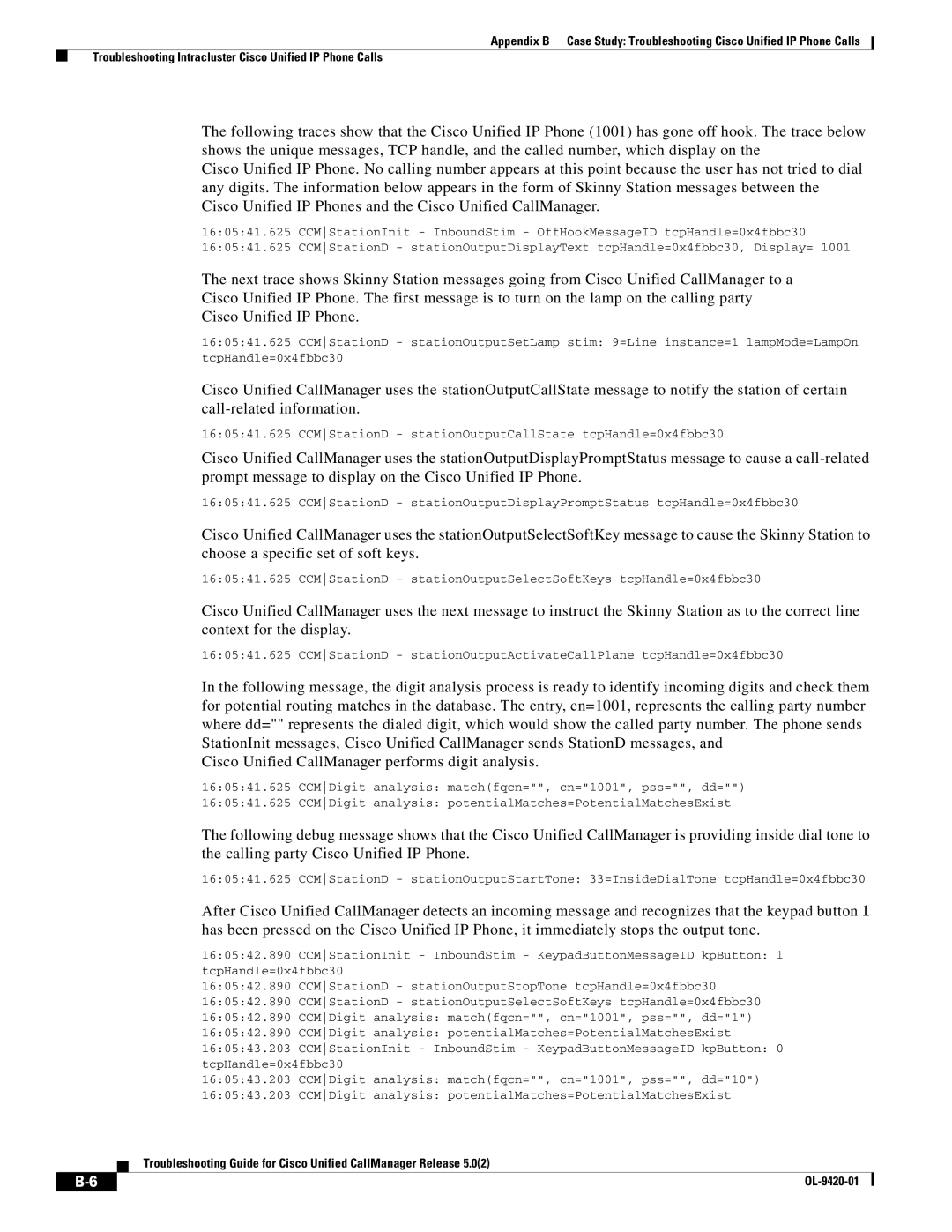
Appendix B Case Study: Troubleshooting Cisco Unified IP Phone Calls
Troubleshooting Intracluster Cisco Unified IP Phone Calls
The following traces show that the Cisco Unified IP Phone (1001) has gone off hook. The trace below shows the unique messages, TCP handle, and the called number, which display on the
Cisco Unified IP Phone. No calling number appears at this point because the user has not tried to dial any digits. The information below appears in the form of Skinny Station messages between the Cisco Unified IP Phones and the Cisco Unified CallManager.
16:05:41.625 CCMStationInit - InboundStim - OffHookMessageID tcpHandle=0x4fbbc30 16:05:41.625 CCMStationD - stationOutputDisplayText tcpHandle=0x4fbbc30, Display= 1001
The next trace shows Skinny Station messages going from Cisco Unified CallManager to a
Cisco Unified IP Phone. The first message is to turn on the lamp on the calling party
Cisco Unified IP Phone.
16:05:41.625 CCMStationD - stationOutputSetLamp stim: 9=Line instance=1 lampMode=LampOn tcpHandle=0x4fbbc30
Cisco Unified CallManager uses the stationOutputCallState message to notify the station of certain
16:05:41.625 CCMStationD - stationOutputCallState tcpHandle=0x4fbbc30
Cisco Unified CallManager uses the stationOutputDisplayPromptStatus message to cause a
16:05:41.625 CCMStationD - stationOutputDisplayPromptStatus tcpHandle=0x4fbbc30
Cisco Unified CallManager uses the stationOutputSelectSoftKey message to cause the Skinny Station to choose a specific set of soft keys.
16:05:41.625 CCMStationD - stationOutputSelectSoftKeys tcpHandle=0x4fbbc30
Cisco Unified CallManager uses the next message to instruct the Skinny Station as to the correct line context for the display.
16:05:41.625 CCMStationD - stationOutputActivateCallPlane tcpHandle=0x4fbbc30
In the following message, the digit analysis process is ready to identify incoming digits and check them for potential routing matches in the database. The entry, cn=1001, represents the calling party number where dd="" represents the dialed digit, which would show the called party number. The phone sends StationInit messages, Cisco Unified CallManager sends StationD messages, and
Cisco Unified CallManager performs digit analysis.
16:05:41.625 CCMDigit analysis: match(fqcn="", cn="1001", pss="", dd="")
16:05:41.625 CCMDigit analysis: potentialMatches=PotentialMatchesExist
The following debug message shows that the Cisco Unified CallManager is providing inside dial tone to the calling party Cisco Unified IP Phone.
16:05:41.625 CCMStationD - stationOutputStartTone: 33=InsideDialTone tcpHandle=0x4fbbc30
After Cisco Unified CallManager detects an incoming message and recognizes that the keypad button 1 has been pressed on the Cisco Unified IP Phone, it immediately stops the output tone.
16:05:42.890 CCMStationInit - InboundStim - KeypadButtonMessageID kpButton: 1 tcpHandle=0x4fbbc30
16:05:42.890 CCMStationD - stationOutputStopTone tcpHandle=0x4fbbc30 16:05:42.890 CCMStationD - stationOutputSelectSoftKeys tcpHandle=0x4fbbc30 16:05:42.890 CCMDigit analysis: match(fqcn="", cn="1001", pss="", dd="1") 16:05:42.890 CCMDigit analysis: potentialMatches=PotentialMatchesExist 16:05:43.203 CCMStationInit - InboundStim - KeypadButtonMessageID kpButton: 0 tcpHandle=0x4fbbc30
16:05:43.203 CCMDigit analysis: match(fqcn="", cn="1001", pss="", dd="10")
16:05:43.203 CCMDigit analysis: potentialMatches=PotentialMatchesExist
Troubleshooting Guide for Cisco Unified CallManager Release 5.0(2)
|
| ||
|
|
